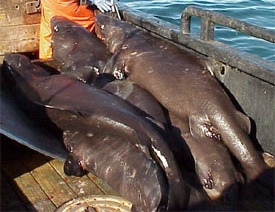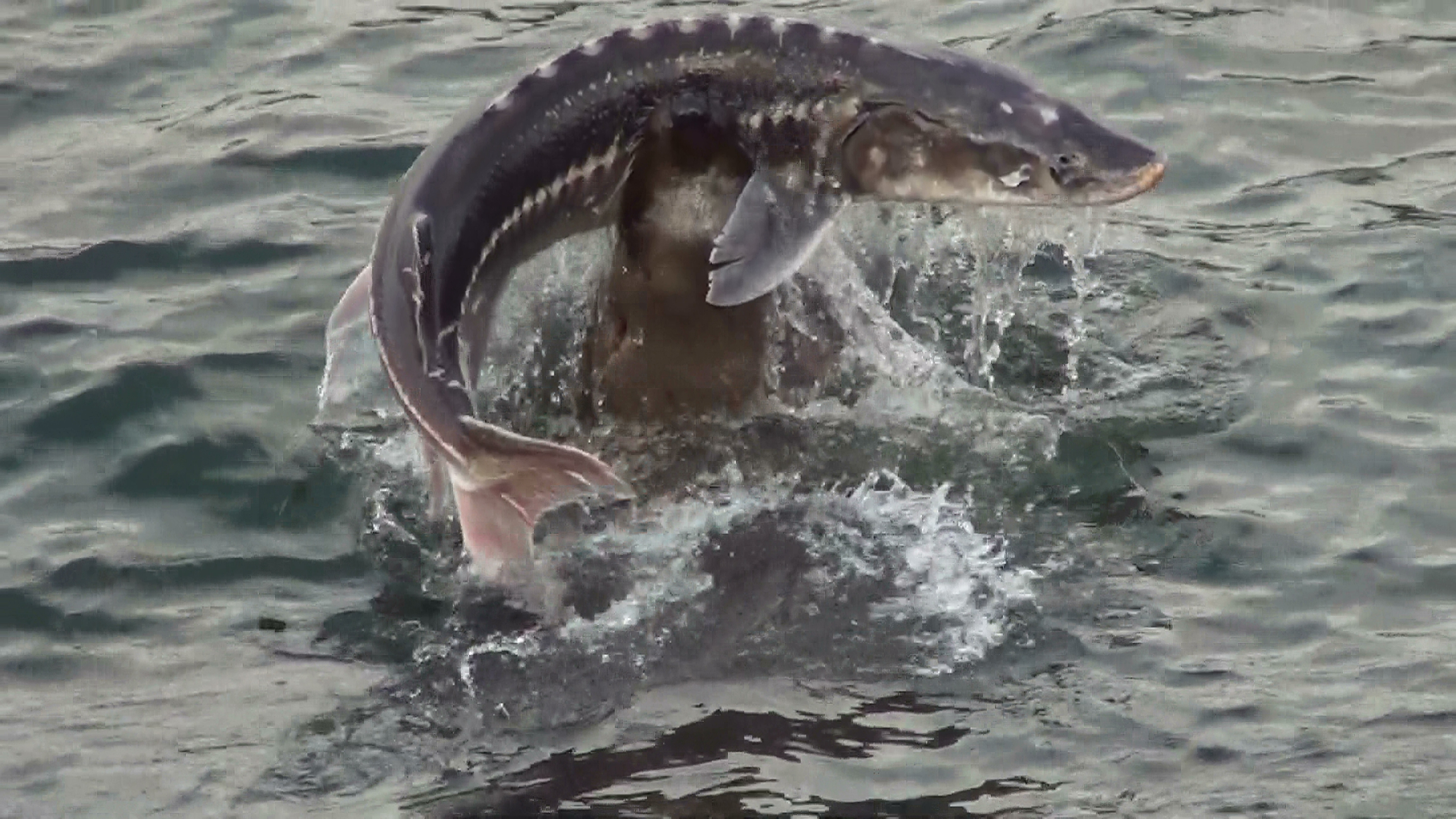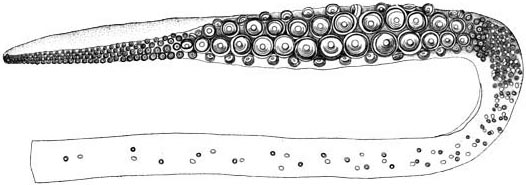|
Pacific Sleeper Shark
The Pacific sleeper shark (''Somniosus pacificus'') is a sleeper shark of the family Somniosidae, found in the North Pacific on continental shelves and slopes in Arctic and temperate waters between latitudes 70°N and 22°N, from the surface to deep. Records from southern oceans are likely misidentifications of relatives. Its length is up to , although it could possibly reach lengths in excess of . Feeding habits Pacific sleeper sharks, which are thought to be both predators and scavengers, can glide through the water with little body movement and little hydrodynamic noise, making them successful stealth predators. They feed by means of suction and cutting of their prey. They have large mouths that can essentially inhale prey and their teeth cut up any pieces that are too large to swallow. They show a characteristic rolling motion of the head when feeding. Only in Alaska has the shark's diet been studied - most sharks' stomachs contain remains of giant Pacific octopus. They a ... [...More Info...] [...Related Items...] OR: [Wikipedia] [Google] [Baidu] |
Giant Pacific Octopus
The giant Pacific octopus (''Enteroctopus dofleini''), also known as the North Pacific giant octopus, is a large marine cephalopod belonging to the genus ''Enteroctopus''. Its spatial distribution includes the coastal North Pacific, along Mexico (Baja California), The United States (California, Oregon, Washington, and Alaska), Canada (British Columbia), Russia, Eastern China, Japan, and the Korean Peninsula. It can be found from the intertidal zone down to , and is best adapted to cold, oxygen-rich water. It is the largest octopus species, based on a scientific record of a individual weighed live. Etymology The specific name ''dofleini'' was chosen by Gerhard Wülker in honor of German scientist Franz Theodor Doflein. It was moved to genus ''Enteroctopus'' by Eric Hochberg in 1998. Description Size ''E. dofleini'' is distinguished from other species by its large size. Adults usually weigh around , with an arm span up to . [...More Info...] [...Related Items...] OR: [Wikipedia] [Google] [Baidu] |
Henry Bryant Bigelow
Henry Bryant Bigelow (October 3, 1879 – December 11, 1967) was an American oceanographer and marine biologist. He is the grandson of Henry Bryant who was an American physician and naturalist. After graduating from Harvard in 1901, he began working with famed ichthyologist Alexander Agassiz. Bigelow accompanied Agassiz on several major marine science expeditions including one aboard the ''Albatross'' in 1907. He began working at the Museum of Comparative Zoology in 1905 and joined Harvard's faculty in 1906 where he worked for 62 years. In 1911, Bigelow was elected a Fellow of the American Academy of Arts and Sciences. He helped found the Woods Hole Oceanographic Institution in 1930 and was its founding director. During his life he published more than one hundred papers and several books. He was a world-renowned expert on coelenterates and elasmobranchs. In 1948 Bigelow was awarded the Daniel Giraud Elliot Medal from the National Academy of Sciences. Honors The Henry ... [...More Info...] [...Related Items...] OR: [Wikipedia] [Google] [Baidu] |
Flounder
Flounders are a group of flatfish species. They are demersal fish, found at the bottom of oceans around the world; some species will also enter estuaries. Taxonomy The name "flounder" is used for several only distantly related species, though all are in the suborder Pleuronectoidei (families Achiropsettidae, Bothidae, Pleuronectidae, Paralichthyidae, and Samaridae). Some of the better known species that are important in fisheries are: * Western Atlantic ** Gulf flounder – ''Paralichthys albigutta'' ** Southern flounder – ''Paralichthys lethostigma'' ** Summer flounder (also known as ''fluke'') – ''Paralichthys dentatus'' ** Winter flounder – ''Pseudopleuronectes americanus'' * European waters ** European flounder – ''Platichthys flesus'' ** Witch flounder – ''Glyptocephalus cynoglossus'' * North Pacific ** Halibut – ''Hippoglossus stenolepis'' ** Olive flounder – ''Paralichthys olivaceus'' Eye migration Larval flounder are born with one eye on e ... [...More Info...] [...Related Items...] OR: [Wikipedia] [Google] [Baidu] |
Steller Sea Lion
The Steller sea lion (''Eumetopias jubatus''), also known as the Steller's sea lion and northern sea lion, is a near-threatened species of sea lion in the northern Pacific. It is the sole member of the genus ''Eumetopias'' and the largest of the eared seals (Otariidae). Among pinnipeds, only the walrus and the two species of elephant seals are bigger. The species is named for the naturalist Georg Wilhelm Steller, who first described them in 1741. The Steller sea lion has attracted considerable attention in recent decades, owing to significant and largely unexplained declines in their numbers over an extensive portion of their northern range in Alaska. Description Adult animals are lighter in color than most sea lions, ranging from pale yellow to tawny and occasionally reddish. Steller sea lion pups are born almost black, weighing around , and remain dark in coloration for several months. Females and males both grow rapidly until the fifth year, after which female grow ... [...More Info...] [...Related Items...] OR: [Wikipedia] [Google] [Baidu] |
Marine Mammal
Marine mammals are aquatic mammals that rely on the ocean and other marine ecosystems for their existence. They include animals such as seals, whales, manatees, sea otters and polar bears. They are an informal group, unified only by their reliance on marine environments for feeding and survival. Marine mammal adaptation to an aquatic lifestyle varies considerably between species. Both cetaceans and sirenians are fully aquatic and therefore are obligate water dwellers. Seals and sea-lions are semiaquatic; they spend the majority of their time in the water but need to return to land for important activities such as mating, breeding and molting. In contrast, both otters and the polar bear are much less adapted to aquatic living. The diets of marine mammals vary considerably as well; some eat zooplankton, others eat fish, squid, shellfish, or sea-grass, and a few eat other mammals. While the number of marine mammals is small compared to those found on land, their roles in ... [...More Info...] [...Related Items...] OR: [Wikipedia] [Google] [Baidu] |
Cephalopoda
A cephalopod is any member of the molluscan class Cephalopoda (Greek plural , ; "head-feet") such as a squid, octopus, cuttlefish, or nautilus. These exclusively marine animals are characterized by bilateral body symmetry, a prominent head, and a set of arms or tentacles (muscular hydrostats) modified from the primitive molluscan foot. Fishers sometimes call cephalopods "inkfish", referring to their common ability to squirt ink. The study of cephalopods is a branch of malacology known as teuthology. Cephalopods became dominant during the Ordovician period, represented by primitive nautiloids. The class now contains two, only distantly related, extant subclasses: Coleoidea, which includes octopuses, squid, and cuttlefish; and Nautiloidea, represented by ''Nautilus'' and ''Allonautilus''. In the Coleoidea, the molluscan shell has been internalized or is absent, whereas in the Nautiloidea, the external shell remains. About 800 living species of cephalopods have been i ... [...More Info...] [...Related Items...] OR: [Wikipedia] [Google] [Baidu] |
Giant Squid
The giant squid (''Architeuthis dux'') is a species of deep-ocean dwelling squid in the family Architeuthidae. It can grow to a tremendous size, offering an example of abyssal gigantism: recent estimates put the maximum size at around Tracey, D. M., O. F. Anderson & J. R. Naylor (2011)''A guide to common deepsea invertebrates in New Zealand waters. Third edition.''National Institute of Water and Atmospheric Research, Wellington. 317 pp.Yukhov, V. L. (2014)Гигантские кальмары рода ''Architeuthis'' в Южном океане / Giant calmaries ''Аrchiteuthis'' in the Southern ocean igantskiye kalmary roda ''Architeuthis'' v Yuzhnom okeane.''Ukrainian Antarctic Journal'' no. 13: 242–253. for females and for males, from the posterior fins to the tip of the two long tentacles (longer than the colossal squid at an estimated , but substantially lighter, due to the tentacles making up most of the length). The mantle of the giant squid is about lon ... [...More Info...] [...Related Items...] OR: [Wikipedia] [Google] [Baidu] |
Trinidad, California
Trinidad ( Spanish for "Trinity"; Yurok: ''Chuerey'') is a seaside city in Humboldt County, located on the Pacific Ocean north of the Arcata-Eureka Airport and north of the college town of Arcata. Trinidad is noted for its coastline with ten public beaches and offshore rocks, part of the California Coastal National Monument, of which Trinidad is a Gateway City. Fishing operations related to Trinidad Harbor are vital to both local tourism and commercial fishery interests in the region. Situated at an elevation of above its own North Coast harbor, Trinidad is one of California's smallest incorporated cities by population (367 residents in 2010, up from 311 residents in 2000). History ] Before 1700 AD, Yurok people established the village of Tsurai on bluffs overlooking Trinidad Bay. The first European sighting of Trinidad Harbor was by the Manila galleon captain Sebastian Rodriguez Cermeño, who did not make landfall. The next visit was by Bruno de Heceta and Juan Franc ... [...More Info...] [...Related Items...] OR: [Wikipedia] [Google] [Baidu] |
Harbor Porpoise
The harbour porpoise (''Phocoena phocoena'') is one of eight extant species of porpoise. It is one of the smallest species of cetacean. As its name implies, it stays close to coastal areas or river estuaries, and as such, is the most familiar porpoise to whale watchers. This porpoise often ventures up rivers, and has been seen hundreds of kilometres from the sea. The harbour porpoise may be polytypic, with geographically distinct populations representing distinct races: ''P. p. phocoena'' in the North Atlantic and West Africa, ''P. p. relicta'' in the Black Sea and Sea of Azov, an unnamed population in the northwestern Pacific and ''P. p. vomerina'' in the northeastern Pacific. Taxonomy The English word porpoise comes from the French ( Old French , 12th century), which is from Medieval Latin , which is a compound of ''porcus'' (pig) and (fish). The old word is probably a loan-translation of a Germanic word, compare Danish ''marsvin'' and Middle Dutch ''mereswijn'' (sea swi ... [...More Info...] [...Related Items...] OR: [Wikipedia] [Google] [Baidu] |
Pacific Salmon
''Oncorhynchus'' is a genus of fish in the family Salmonidae; it contains the Pacific salmon and Pacific trout. The name of the genus is derived from the Greek ὄγκος (ónkos, “lump, bend”) + ῥύγχος (rhúnkhos, “snout”), in reference to the hooked snout (the "kype") that the males develop during mating season. Range Salmon and trout with native ranges in waters draining to the Pacific Ocean are members of the genus. Their range extends from Beringia southwards, roughly to Taiwan in the west and Mexico to the east. In North America, some subspecies of '' O. clarkii'' are native in the Rocky Mountains and Great Basin, while others are native to the Rio Grande and western tributaries of the Mississippi River Basin which drain to the Gulf of Mexico, rather than to the Pacific. Several species of ''Oncorhynchus'' have been introduced into non-native waters around the globe, establishing self-sustaining wild populations. The six Pacific salmons of ' ... [...More Info...] [...Related Items...] OR: [Wikipedia] [Google] [Baidu] |
Squid
True squid are molluscs with an elongated soft body, large eyes, eight arms, and two tentacles in the superorder Decapodiformes, though many other molluscs within the broader Neocoleoidea are also called squid despite not strictly fitting these criteria. Like all other cephalopods, squid have a distinct head, bilateral symmetry, and a mantle. They are mainly soft-bodied, like octopuses, but have a small internal skeleton in the form of a rod-like gladius or pen, made of chitin. Squid diverged from other cephalopods during the Jurassic and occupy a similar role to teleost fish as open water predators of similar size and behaviour. They play an important role in the open water food web. The two long tentacles are used to grab prey and the eight arms to hold and control it. The beak then cuts the food into suitable size chunks for swallowing. Squid are rapid swimmers, moving by jet propulsion, and largely locate their prey by sight. They are among the most intelligent o ... [...More Info...] [...Related Items...] OR: [Wikipedia] [Google] [Baidu] |
Snail
A snail is, in loose terms, a shelled gastropod. The name is most often applied to land snails, terrestrial pulmonate gastropod molluscs. However, the common name ''snail'' is also used for most of the members of the molluscan class Gastropoda that have a coiled shell that is large enough for the animal to retract completely into. When the word "snail" is used in this most general sense, it includes not just land snails but also numerous species of sea snails and freshwater snails. Gastropods that naturally lack a shell, or have only an internal shell, are mostly called '' slugs'', and land snails that have only a very small shell (that they cannot retract into) are often called ''semi-slugs''. Snails have considerable human relevance, including as food items, as pests, and as vectors of disease, and their shells are used as decorative objects and are incorporated into jewelry. The snail has also had some cultural significance, tending to be associated with lethargy. ... [...More Info...] [...Related Items...] OR: [Wikipedia] [Google] [Baidu] |





.jpg)




.jpg)